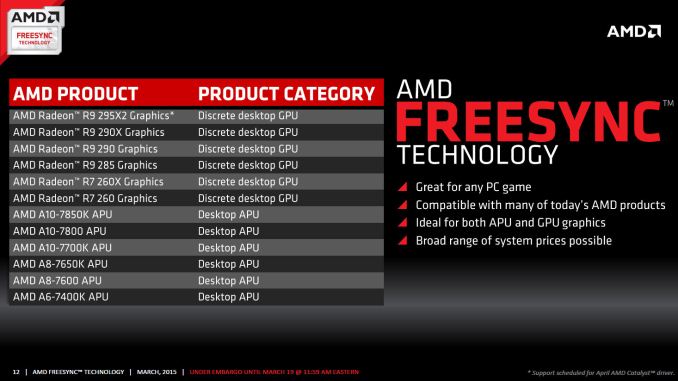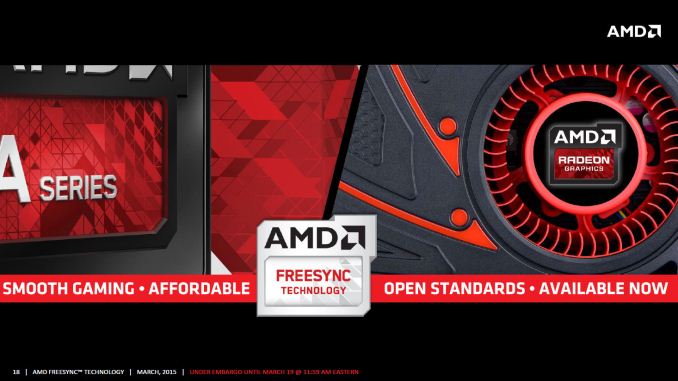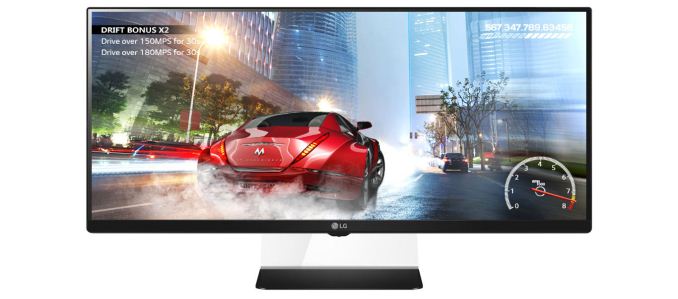The AMD FreeSync Review
by Jarred Walton on March 19, 2015 12:00 PM ESTClosing Thoughts
It took a while to get here, but if the proof is in the eating of the pudding, FreeSync tastes just as good as G-SYNC when it comes to adaptive refresh rates. Within the supported refresh rate range, I found nothing to complain about. Perhaps more importantly, while you’re not getting a “free” monitor upgrade, the current prices of the FreeSync displays are very close to what you’d pay for an equivalent display that doesn’t have adaptive sync. That’s great news, and with the major scaler manufacturers on board with adaptive sync the price disparity should only shrink over time.
The short summary is that FreeSync works just as you’d expect, and at least in our limited testing so far there have been no problems. Which isn’t to say that FreeSync will work with every possible AMD setup right now. As noted last month, the initial FreeSync driver that AMD provided (Catalyst 15.3 Beta 1) only allows FreeSync to work with single GPU configurations. Another driver should be coming next month that will support FreeSync with CrossFire setups.
Besides needing a driver and FreeSync display, you also need a GPU that uses AMD’s GCN 1.1 or later architecture. The list at present consists of the R7 260/260X, R9 285, R9 290/290X/295X2 discrete GPUs, as well as the Kaveri APUs – A6-7400K, A8-7600/7650K, and A10-7700K/7800/7850K. First generation GCN 1.0 cards (HD 7950/7970 or R9 280/280X and similar) are not supported.
All is not sunshine and roses, however. Part of the problem with reviewing something like FreeSync is that we're inherently tied to the hardware we receive, in this case the LG 34UM67 display. Armed with an R9 290X and running at the native resolution, the vast majority of games will run at 48FPS or above even at maximum detail settings, though of course there are exceptions. This means they look and feel smooth. But what happens with more demanding games or with lower performance GPUs? If you're running without VSYNC, you'd get tearing below 48FPS, while with VSYNC you'd get stuttering.
Neither is ideal, but how much this impacts your experience will depend on the game and individual. G-SYNC handles dropping below the minimum FPS more gracefully than FreeSync, though if you're routinely falling below the minimum FreeSync refresh rate we'd argue that you should lower the settings. Mostly what you get with FreeSync/G-SYNC is the ability to have smooth gaming at 40-60 FPS and not just 60+ FPS.
Other sites are reporting ghosting on FreeSync displays, but that's not inherent to the technology. Rather, it's a display specific problem (just as the amount of ghosting on normal LCDs is display specific). Using higher quality panels and hardware designed to reduce/eliminate ghosting is the solution. The FreeSync displays so far appear to not have the same level of anti-ghosting as the currently available G-SYNC panels, which is unfortunate if true. (Note that we've only looked at the LG 34UM67, so we can't report on all the FreeSync displays.) Again, ghosting shouldn't be a FreeSync issue so much as a panel/scaler/firmware problem, so we'll hold off on further commentary until we get to the monitor reviews.
One final topic to address is something that has become more noticeable to me over the past few months. While G-SYNC/FreeSync can make a big difference when frame rates are in the 40~75 FPS range, as you go beyond that point the benefits are a lot less clear. Take the 144Hz ASUS ROG Swift as an example. Even with G-SYNC disabled, the 144Hz refresh rate makes tearing rather difficult to spot, at least in my experience. Considering pixel response times for LCDs are not instantaneous and combine that with the way our human eyes and brain process the world and for all the hype I still think having high refresh rates with VSYNC disabled gets you 98% of the way to the goal of smooth gaming with no noticeable visual artifacts (at least for those of us without superhuman eyesight).
Overall, I’m impressed with what AMD has delivered so far with FreeSync. AMD gamers in particular will want to keep an eye on the new and upcoming FreeSync displays. They may not be the “must have” upgrade right now, but if you’re in the market and the price premium is less than $50, why not get FreeSync? On the other hand, for NVIDIA users things just got more complicated. Assuming you haven’t already jumped on the G-SYNC train, there’s now this question of whether or not NVIDIA will support non-G-SYNC displays that implement DisplayPort’s Adaptive Sync technology. I have little doubt that NVIDIA can support FreeSync panels, but whether they will support them is far less certain. Given the current price premium on G-SYNC displays, it’s probably a good time to sit back and wait a few months to see how things develop.
There is one G-SYNC display that I’m still waiting to see, however: Acer’s 27” 1440p144 IPS (AHVA) XB270HU. It was teased at CES and it could very well be the holy grail of displays. It’s scheduled to launch next month, and official pricing is $799 (with some pre-orders now online at higher prices). We might see a FreeSync variant of the XB270HU as well in the coming months, if not from Acer than likely from some other manufacturer. For those that work with images and movies as well as playing games, IPS/AHVA displays with G-SYNC or FreeSync support are definitely needed.
Wrapping up, if you haven’t upgraded your display in a while, now is a good time to take stock of the various options. IPS and other wide viewing angle displays have come down quite a bit in pricing, and there are overclockable 27” and 30” IPS displays that don’t cost much at all. Unfortunately, if you want a guaranteed high refresh rate, there’s a good chance you’re going to have to settle for TN. The new UltraWide LG displays with 75Hz IPS panels at least deliver a moderate improvement though, and they now come with FreeSync as an added bonus.
Considering a good display can last 5+ years, making a larger investment isn’t a bad idea, but by the same token rushing into a new display isn’t advisable either as you don't want to end up stuck with a "lemon" or a dead technology. Take some time, read the reviews, and then find the display that you will be happy to use for the next half decade. At least by then we should have a better idea of which display technologies will stick around.













350 Comments
View All Comments
Hrel - Thursday, March 19, 2015 - link
I'm so sick of this proprietary shit, when companies want to do something new why not work with the other companies in the industry to come up with the best solution for the problem and make it universal? Customers NEVER jump onto a technology that only works from one company, we aren't going to commit to a monopoly. I get that they want a competitive edge in the market, but it literally never works that way. What happens is they spend all this money on R&D, marketing, prototyping, waste everyone's time with marketing and reviews only to have a handful of people pick it up (probably too few to even break even) and then it stops growing right there until a universal standard comes out that the industry adapts as a whole.Just fucking stop wasting everyone's time and money and choose cooperation from the start!
HunterKlynn - Thursday, March 19, 2015 - link
For the record, AMDs solution here *is* an attempt at an open standard. GSync is the proprietary one.dragonsqrrl - Thursday, March 19, 2015 - link
...Black Obsidian - Thursday, March 19, 2015 - link
It's hard to be more open than being an official (albeit optional) part of the DisplayPort spec itself.DominionSeraph - Thursday, March 19, 2015 - link
I'm sure AMD will be happy to give you the masks to the 290X and 390X, if you only ask. "I'm sick of there only being two players in the market. Why don't you let me in? I'm sure I could sell your products for less than your prices!"lordken - Thursday, March 19, 2015 - link
next time when you try to make someone look stupid, try no to look like fool by yourself. Another dogma believer that thinks without patents world will end. Same as copyright believers that music&entertainment without copyright will stop to exist...If you think about it, you can see that patents can actually pretty much slow down technology advancement. You can even see that today with Intel CPUs, as AMD cannot catch up and CPUs are patent locked we are left to be milked by Intel with minimal performance gains between generations. If either AMD would have better CPUs or could simply copy good parts from Intel and put into their design today, imho, we would be much far with performance. Also look around you and see that 3D printing boom? Guess what few years back and last year patents expired and allowed this. Yes 3D printing was invented 30years ago, yet it gets to your desk only today. So much for patent believers.
btw even if AMD would give you their blueprints what would you do? Start selling R390X tomorrow right? Manufactured out of thin air. By the time you could sell R390X we would be at 590 generation. Possibly only nvidia/intel would be able to benefit that sooner (which isnt necesarily a bad thing)
lordken - Thursday, March 19, 2015 - link
@Hrel: a) cause most corporations are run by greedy bastards imho b) today managers of said corporations cant employ common sense and are disconnected from reality making stupid/bad decisions. I see it in big corporation i work for...so using brain and "pro-consumer" way of thinking is forbidden.
Flunk - Thursday, March 19, 2015 - link
Please just support the Adaptive VSync standard Nvidia, your G-Sync implmentation doesn't have any benefits over it. You don't need to call it FreeSync, but we all need to settle on one standard because if I have to be locked in to one brand of GPU based on my monitor isn't not going to be the one that's not using industry standards.Murloc - Thursday, March 19, 2015 - link
a monitor lasts much longer than a GPU and costs more too for most users out there so yeah, standards win.They can call it adaptive sync as that's what it is. A Displayport standard.
praeses - Thursday, March 19, 2015 - link
It would be interesting to see input lag comparisons and videos of panning scenes in games that would typically cause tearing captured at higher speed played in slow motion.